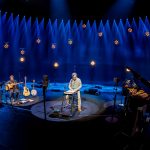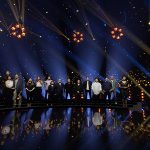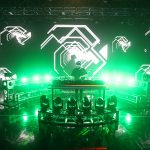LabeLive and Atlanta Rigging Systems Raise the Roof at the Grand Ole Opry
The K-Love Fan Awards is the premiere “Ultimate fan experience” for the Christian Contemporary Music industry hosted at the Grand Ole Opry in Nashville, TN. The event is an opportunity for fans to see 22 of their favorite artists perform and accept awards on the historic main stage.
Sponsored by K-Love Radio Network and executive produced by John Sanders LLC with Steve Strout, the event provides a contemporary, popular culture showcase for artists with a Christian message.
Corbin Hand, owner of X1Live, along with John Boyd, president/creative director of
LabeLive, served as the event’s production and show designers, with Hand also taking on production manager duties and overseeing all the scenic, lighting and video design details.

Production Challenges
The challenges presented to Hand were based on working around the Grand Ole Opry set and shows, which involved both time constraints and limited staging area.
“The show loads in on Wednesday and loads back out on Friday for the Grand Ole Opry shows Friday and Saturday,” relates Hand. “We load back in at 5 a.m. Sunday morning for a hoist rehearsal, dress rehearsal, and then show at 6 p.m. Another unique challenge is that we had 22 artist performances and an average of six minutes to patch and line check between performances. Also, 100 percent of the performances are completely live.
“Because of the quick transition from the House show to our show,” Hand continues, “we are unable to strike the iconic Opry Barn.” To meet the challenges of providing different looks for each of the 22 artists that performed, and facilitate the rapid set change during award presentations, Corbin called upon Atlanta Rigging Systems (ARS) for a fully automated hoist system.
Neil Montour, project manager for ARS explains. “Corbin proposed an ambitious design with an extremely tight timeline for a one off, which had to be aesthetically pleasing as well as quet.”

The Structural Design
ARS designed a system of five 60 foot sections of 20” x 30” super truss, which cradled 32 Axis variable speed chain hoists, drives and ARS’ proprietary Stinger 1250 winch. This grid supported four articulating hinged lighting truss and three video LED walls.
Between performances, as awards were presented, the various LED walls flew in or out to accommodate the multiple set changes for artists, as well as create the scenic looks for the next act. All the way upstage behind the bands, a truss was rigged with geometric diamond and arrow shaped LED walls, providing additional scenic elements. The four lighting trusses also articulated to create multiple looks for the numerous acts.
Using the Kinesys Elevation 1+ automated system, ARS’ Michele Maglich programmed over 80 separate moves with Vector software for execution during the event.
Downstage left and right in front of the proscenium, 24-foot vertical video walls provided additional content. Artists provided content loaded into a 2K mask sent to them by X1Live.Though the request was made to send all content back three weeks before show day, some did not arrive until the day of the event. Video director Jason Blasing had a busy day loading all the visual content into a Resolume media server, cued to time code.
The Lighting Design
Chris Lisle Lighting Design (CLLD) provided the event’s lighting design, in collaboration with Corbin Hand and John Boyd.
“We kept the design very straightforward,” says Lisle, “with a selection of spot, wash, and effect fixtures. Mike Marcario (programmer) approached the changing truss positions so that there were only a few basic positions, with one or two specific positions dedicated to each act. This allowed us to stay organized and work efficiently within the limited time frame we had on site with the actual system.
“Mike spent about three to four days in the studio getting the core looks and cues in,” Lisle adds. “Once we got on site, we hustled to update focuses, effects, etc. Mike did all the programming and operation on the main rig, while I did key light and camera ‘eye candy’ on a separate console. Erik Parker joined us for the one rehearsal we had, and was on a third console updating focuses, and other palettes as we were running them. Given this was our one shot to see everything with bands/music, we wanted to make sure we made the most of that time for sure.”
“Personally, this is the most difficult show that I do,” Hand concludes, “but it is definitely the most rewarding.”


